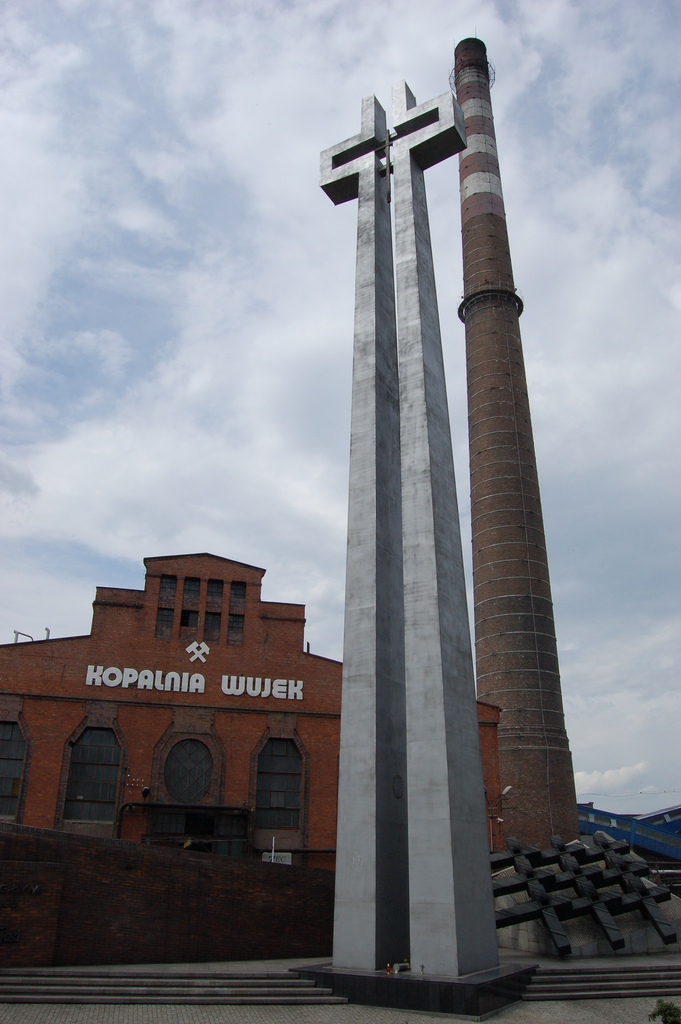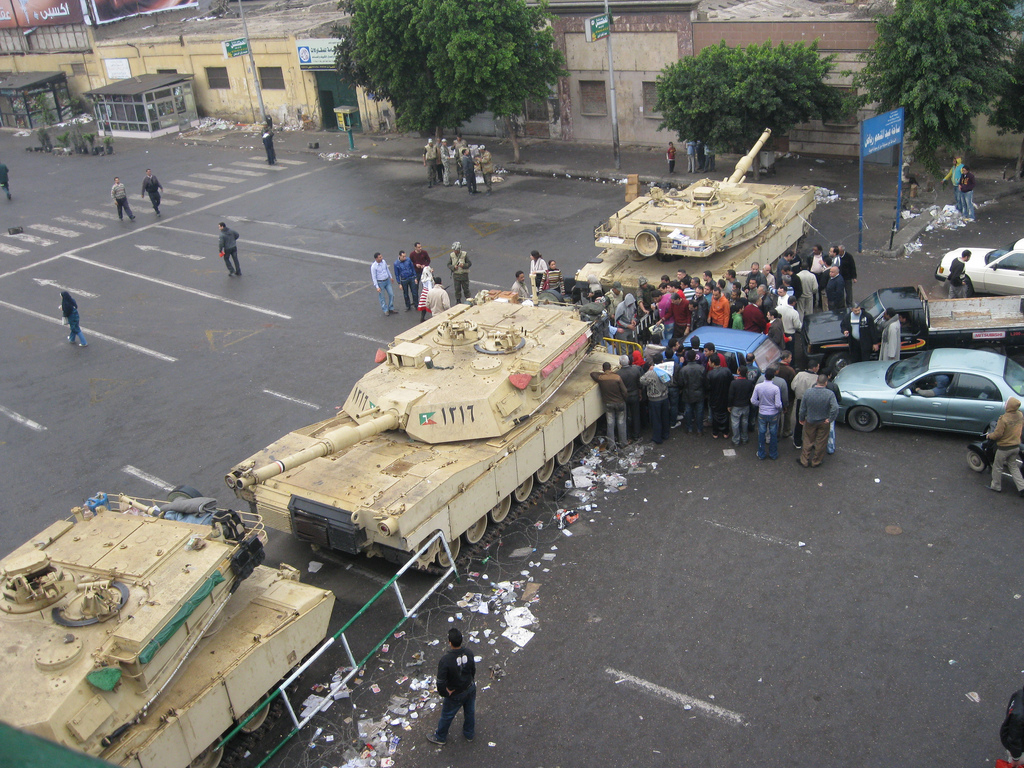|
Pacification Of Wujek
The Pacification of Wujek was a strike-breaking action by the Polish police and army at the Wujek Coal Mine in Katowice, Poland, culminating in the massacre of nine striking miners on December 16, 1981. It was part of a large-scale action aimed to break the Solidarity free trade union after the introduction of martial law in Poland in 1981. Although the strike was suppressed, in a longer term, it turned out to be a milestone towards the collapse of the authoritarian system in Poland and, ultimately, to the collapse of the Eastern Bloc. It was a site of numerous protests, including by Solidarity activist Anna Walentynowicz who commemorated a plaque to the murdered miners shortly after she left prison at Gołdap. The massacre On December 16, three days after the introduction of the martial law in Poland, pro-Solidarity miners striking against the declaration of the martial law by General Wojciech Jaruzelski were dispersed by the troops of the Polish army and police. The forces us ... [...More Info...] [...Related Items...] OR: [Wikipedia] [Google] [Baidu] |
Martial Law
Martial law is the imposition of direct military control of normal civil functions or suspension of civil law by a government, especially in response to an emergency where civil forces are overwhelmed, or in an occupied territory. Use Martial law can be used by governments to enforce their rule over the public, as seen in multiple countries listed below. Such incidents may occur after a coup d'état ( Thailand in 2006 and 2014, and Egypt in 2013); when threatened by popular protest (China, Tiananmen Square protests of 1989); to suppress political opposition ( martial law in Poland in 1981); or to stabilize insurrections or perceived insurrections. Martial law may be declared in cases of major natural disasters; however, most countries use a different legal construct, such as a state of emergency. Martial law has also been imposed during conflicts, and in cases of occupations, where the absence of any other civil government provides for an unstable population. Examples of ... [...More Info...] [...Related Items...] OR: [Wikipedia] [Google] [Baidu] |
1988 Polish Strikes
The 1988 Polish strikes were a massive wave of workers' strikes which broke out from 21 April, 1988 in the Polish People's Republic. The strikes, as well as street demonstrations, continued throughout spring and summer, ending in early September 1988. These actions shook the Communist regime of the country to such an extent that it was forced to begin talking about recognising Solidarity. As a result, later that year, the regime decided to negotiate with the opposition, which opened way for the 1989 Round Table Agreement. The second, much bigger wave of strikes (August 1988) surprised both the government, and top leaders of Solidarity, who were not expecting actions of such intensity. These strikes were mostly organized by local activists, who had no idea that their leaders from Warsaw had already started secret negotiations with the Communists. Background Late 1980s was the time of deep economic crisis of Poland. The military regime of General Wojciech Jaruzelski did not carry ... [...More Info...] [...Related Items...] OR: [Wikipedia] [Google] [Baidu] |
August 31, 1982 Demonstrations In Poland
The 1982 demonstrations in Poland refers to anti-government street demonstrations organized by underground Solidarity to commemorate the second anniversary of the Gdańsk Agreement. The bloodiest protest occurred in southwestern Poland, in the town of Lubin, on August 31, 1982. The Lubin demonstration resulted in three protesters killed by Communist services, and an unknown number of wounded.Encyclopedia of Solidarity – Lubin Crime. Article written by Lukasz Kaminski, historian of Wroclaw University Encyklopedia-solidarnosci.pl. Retrieved on August 31, 2011. On the same day, rallies and demonstrations took place in several cities across the country. According to Solidarity sources, there were four mor ... [...More Info...] [...Related Items...] OR: [Wikipedia] [Google] [Baidu] |
1981 Warning Strike In Poland
In the early spring of 1981 in Poland, during the Bydgoszcz events, several members of the Solidarity movement, including Jan Rulewski, Mariusz Łabentowicz and Roman Bartoszcze, were brutally beaten by the security services, such as Milicja Obywatelska and ZOMO. The ''Bydgoszcz events'' soon became widely known across Poland, and on 24 March 1981 Solidarity decided to go on a nationwide strike in protest against the violence. The strike was planned for Tuesday, 31 March 1981. On 25 March, Lech Wałęsa met Deputy Prime Minister Mieczysław Rakowski of the Polish United Workers' Party, but their talks were fruitless. Two days later, a four-hour national warning strike took place. It was the biggest strike in the history of not only Poland but of the Warsaw Pact itself. According to several sources, between 12 million and 14 million P ... [...More Info...] [...Related Items...] OR: [Wikipedia] [Google] [Baidu] |
Kazimierz Kutz
Kazimierz Julian Kutz (16 February 1929 – 18 December 2018) was a Polish film director, author, journalist and politician, one of the representatives of the Polish Film School and a deputy speaker of the Senate of Poland. Biography Kazimierz Kutz was born on 16 February 1929 in Szopienice, since 1960 district of Katowice, to a railway worker and a former partisan of the Silesian Uprisings. After the World War II Kutz graduated from gymnasium in Mysłowice and in 1949 was admitted to the Łódź Film School. After finishing his studies in 1954 he started working as an assistant to Andrzej Wajda. His film debut was ''Krzyż Walecznych'' (1959). Since then he finished more than 20 pictures, including six about his home region - Silesia. He is also famous for directing theatre plays on some of the most prominent scenes of Poland, including National Stary Theatre in Kraków and National Theatre in Warsaw, as well as several plays for the Polish television. In 1972, he founded t ... [...More Info...] [...Related Items...] OR: [Wikipedia] [Google] [Baidu] |
Polska Agencja Prasowa
The Polish Press Agency ( pl, Polska Agencja Prasowa, PAP) is Poland's national news agency, producing and distributing political, economic, social, and cultural news as well as events information. The agency has 14 news desks in its headquarters in Warsaw and 24 regional bureaux. As of 2013, PAP had nearly 500 employees and associates, including 300 journalists in Warsaw, 70 regional correspondents, 40 photojournalists and 30 foreign correspondents (among others in Berlin, Brussels, Kiev, London, Madrid, Moscow, New York, Paris, Rome, Sofia, Stockholm, Washington and Vilnius). In May 2018, PAP launched an English-language news portal called Thefirstnews.com that focuses mainly on events in Poland, claiming that international media did not always portray the country "entirely accurately" and with the goal of reaching "specific opinion-forming circles" with the help of social media." In 2019 the company announced plans to extend its foreign correspondent network to additional co ... [...More Info...] [...Related Items...] OR: [Wikipedia] [Google] [Baidu] |
Milicja Obywatelska
Milicja Obywatelska (), in English known as the Citizens' Militia and commonly abbreviated to MO, was the national police organization of the Polish People's Republic. It was established on 7 October 1944 by the Polish Committee of National Liberation, effectively replacing the pre-war police force. The Citizen's Militia would remain the predominant means of policing in Poland until 10 May 1990, when it was transformed back into ''Policja''. The term ''milicja'' had been adapted from the cognate term, ''militsiya'', used in several communist countries. The term is derived from ''militia'', which derives its etymology from the concept of a military force composed of ordinary citizens. In most cases it represented a state-controlled force used to exert political repression, especially with its elite ZOMO squads. Under both communist and post-communist governments, the Polish police system has traditionally operated under the auspices of national authority. Starting at the end of Wor ... [...More Info...] [...Related Items...] OR: [Wikipedia] [Google] [Baidu] |
Polskie Radio
Polskie Radio Spółka Akcyjna (PR S.A.; English: Polish Radio) is Poland's national public-service radio broadcasting organization owned by the State Treasury of Poland. History Polskie Radio was founded on 18 August 1925 and began making regular broadcasts from Warsaw on 18 April 1926. Czesław Miłosz, recipient of the 1980 Nobel Prize in Literature, worked as a literary programmer at Polish Radio Wilno in 1936. Before the Second World War, Polish Radio operated one national channel – broadcast from 1931 from one of Europe's most powerful longwave transmitters, situated at Raszyn just outside Warsaw and destroyed in 1939 due to invasion of German Army – and nine regional stations: *Kraków from 15 February 1927 *Poznań from 24 April 1927 *Katowice from 4 December 1927 *Wilno from 15 January 1928 *Lwów from 15 January 1930 *Łódź from 2 February 1930 *Toruń from 15 January 1935 *Warszawa from 1 March 1937 – known as Warszawa II, the national channel becoming W ... [...More Info...] [...Related Items...] OR: [Wikipedia] [Google] [Baidu] |
International Herald Tribune
The ''International Herald Tribune'' (''IHT'') was a daily English-language newspaper published in Paris, France for international English-speaking readers. It had the aim of becoming "the world's first global newspaper" and could fairly be said to have met that goal. It published under the name ''International Herald Tribune'' from 1967 to 2013. Early years In 1887, James Gordon Bennett Jr. created a Paris edition of his newspaper the '' New York Herald''. He called it the ''Paris Herald''. When Bennett Jr. died, the paper came under the control of Frank Munsey, who bought it along with its parent. In 1924, Munsey sold the paper to the family of Ogden Reid, owners of the ''New-York Tribune'', creating the '' New York Herald Tribune'', while the Paris edition became the ''Paris Herald Tribune''. By 1967, the paper was owned jointly by Whitney Communications, ''The Washington Post'' and ''The New York Times'', and became known as the ''International Herald Tribune'', or ''IHT'' ... [...More Info...] [...Related Items...] OR: [Wikipedia] [Google] [Baidu] |
Infantry Fighting Vehicle
An infantry fighting vehicle (IFV), also known as a mechanized infantry combat vehicle (MICV), is a type of armoured fighting vehicle used to carry infantry into battle and provide direct-fire support. The 1990 Treaty on Conventional Armed Forces in Europe defines an infantry fighting vehicle as "an armoured combat vehicle which is designed and equipped primarily to transport a combat infantry squad, and which is armed with an integral or organic cannon of at least 20 millimeters calibre and sometimes an antitank missile launcher". IFVs often serve both as the principal weapons system and as the mode of transport for a mechanized infantry unit. Infantry fighting vehicles are distinct from armored personnel carriers (APCs), which are transport vehicles armed only for self-defense and not specifically engineered to fight on their own. IFVs are designed to be more mobile than tanks and are equipped with a rapid-firing autocannon or a large conventional gun; they may include side po ... [...More Info...] [...Related Items...] OR: [Wikipedia] [Google] [Baidu] |
Water Cannon
A water cannon is a device that shoots a high-velocity stream of water. Typically, a water cannon can deliver a large volume of water, often over dozens of meters. They are used in firefighting, large vehicle washing, riot control, and mining. Most water cannons fall under the category of a fire monitor. Firefighting Water cannons were first devised for use on fireboats. Extinguishing fires on boats and buildings near the water was much more difficult and dangerous before fireboats were invented. The first fireboat deployed in Los Angeles was commissioned on 1 August 1919. The first fireboat in New York City was ''Marine 1'', deployed 1 February 1891. There may have been other fireboats elsewhere even earlier. Fire trucks deliver water with much the same force and volume as water cannons, and have even been used in riot control situations, but are rarely referred to as water cannons outside this context. Riot control The first truck-mounted water cannon was used for riot c ... [...More Info...] [...Related Items...] OR: [Wikipedia] [Google] [Baidu] |




